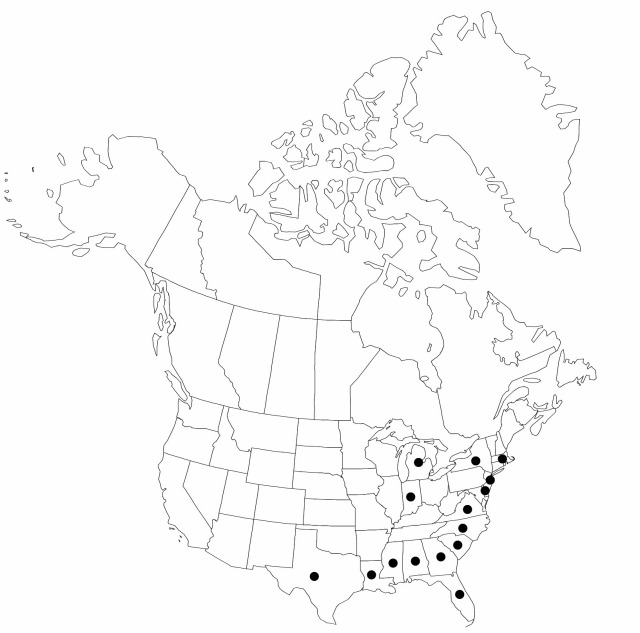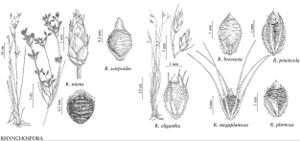Difference between revisions of "Rhynchospora nitens"
Manual ed. 5, 568. 1867.
FNA>Volume Importer |
FNA>Volume Importer |
||
| Line 10: | Line 10: | ||
|name=Scirpus nitens | |name=Scirpus nitens | ||
|authority=Vahl | |authority=Vahl | ||
| + | |rank=species | ||
|publication_title=Enum. Pl. | |publication_title=Enum. Pl. | ||
|publication_place=2: 272. 1805 | |publication_place=2: 272. 1805 | ||
| Line 16: | Line 17: | ||
|name=Isolepis nitens | |name=Isolepis nitens | ||
|authority=(Vahl) Roemer & Schultes | |authority=(Vahl) Roemer & Schultes | ||
| + | |rank=species | ||
}} {{Treatment/ID/Synonym | }} {{Treatment/ID/Synonym | ||
|name=Psilocarya nitens | |name=Psilocarya nitens | ||
|authority=(Vahl) Alph. Wood | |authority=(Vahl) Alph. Wood | ||
| + | |rank=species | ||
}} {{Treatment/ID/Synonym | }} {{Treatment/ID/Synonym | ||
|name=Psilocarya rhynchosporoides | |name=Psilocarya rhynchosporoides | ||
|authority=Torrey | |authority=Torrey | ||
| + | |rank=species | ||
}} | }} | ||
|hierarchy=Cyperaceae;Rhynchospora;Rhynchospora nitens | |hierarchy=Cyperaceae;Rhynchospora;Rhynchospora nitens | ||
| Line 45: | Line 49: | ||
-->{{#Taxon: | -->{{#Taxon: | ||
name=Rhynchospora nitens | name=Rhynchospora nitens | ||
| − | |||
|authority=(Vahl) A. Gray | |authority=(Vahl) A. Gray | ||
|rank=species | |rank=species | ||
| Line 60: | Line 63: | ||
|publication year=1867 | |publication year=1867 | ||
|special status= | |special status= | ||
| − | |source xml=https://jpend@bitbucket.org/aafc-mbb/fna-data-curation.git/src/ | + | |source xml=https://jpend@bitbucket.org/aafc-mbb/fna-data-curation.git/src/f50eec43f223ca0e34566be0b046453a0960e173/coarse_grained_fna_xml/V23/V23_375.xml |
|genus=Rhynchospora | |genus=Rhynchospora | ||
|species=Rhynchospora nitens | |species=Rhynchospora nitens | ||
Revision as of 20:07, 16 December 2019
Plants annual, cespitose or solitary, (10–)20–100 cm; rhizomes absent. Culms erect, leafy, nearly terete or angled, manyribbed. Principal midculm leaves often exceeding inflorescences; blades linear, proximally flattened, 1–5 mm wide, apex trigonous, tapering. Inflorescences terminal and axillary, clusters of corymbs 1–5, usually diffuse; leafy bracts exceeding proximal corymbs. Spikelets dark brown, lanceoloid to ovoid, mostly 4–6(–8) mm, apex acute; fertile scales many, ovate, rounded-convex, 2–3.5 mm, apex acute, midrib mostly included, rarely forming apiculus. Flowers: perianth absent. Fruits 1–1.3(–1.5) mm, body dark brown, tumidly lenticular, nearly orbicular, 0.7–1 × 0.7–1 mm, margins strong, interrupted at tubercle base; surfaces irregularly transversely rugulose with wavy rows of vertical, linear, raised cells; tubercle depressed-triangular, 0.1–0.3 mm, capping fruit summit, base broadly 2lobed.
Phenology: Fruiting summer–fall or all year.
Habitat: Moist to wet sands or peats of stream banks, pond shores, depressions in savannas, marshes
Elevation: 0–100 m
Distribution

Ala., Del., Fla., Ga., Ind., La., Mass., Mich., Miss., N.J., N.Y., N.C., S.C., Tex., Va., West Indies, Central America.
Discussion
Selected References
None.
